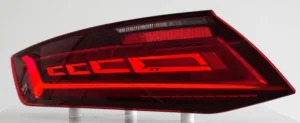Merck. Osram. Fraunhofer. You couldn’t ask for a better team of scientists in Germany to tackle a challenging problem like electroluminescent QLED (EL-QLED).

In a February 2018 announcement by Merck, we learned that Germany had chosen this unique team to launch an intense investigation to make better EL-QLED devices. The project is focused on QDs as the emitter layer, while drawing on OLED-like device architectures and materials.
I had the opportunity to communicate with the team to get a better feel for what differentiates them from others doing QLED work. In the process I learned more about the direction they are hoping to take the technology, and what we might expect to come from this project.
Funding, timeline, goals
The project is funded by the German Federal Ministry of Education and Research, which, when all is said and done, will have contributed €5.5 million by the end of the three year project. Merck and Osram, the industry partners, will contribute a combined € 3.6 million for a total project budget of over €9 million. Given this kind of commitment from the German government as well as the companies involved, it appears the interest in EL-QLED is quite serious. This is by far the biggest commitment I have seen from a government to push forward EL-QLED technology.
The team is one year into the three-year project, led by Merck. While progress has been made, it’s still not clear exactly what the end result will be. They are focused solely on cadmium-free materials, mainly InP QDs, which are nowhere near ready for prime time in EL-QLED devices. InP remains far behind CdSe QDs in terms of both efficiency and reliability, but with the recent uptick in interest (and money) related to this problem, the gap could rapidly close. A major goal of the German consortium is to improve both efficiency and reliability – an approach that will require improvements in materials, processes, devices, and a fundamental understanding of the loss mechanisms. To this end, they have enlisted assistance from some universities.
Who’s doing what?
Merck and Fraunhofer IAP are focused on material development including QD synthesis, charge transport layers, ink development, and device building/testing. Academic partners (U. Augsburg, U Munich, U. Oldenburg) are contributing on the fundamental science side as the team hopes to better understand the loss mechanisms and how to make these devices as efficient and long-lasting as possible. As a device expert, Osram is responsible for making final demonstrations, which are likely to include a simplified display and a car tail-light.
The entire team hopes to draw from the experience of OLED, where charge carrying polymers are used with iridium complexes to generate light. It turns out InP QDs are not far from the OLED iridium complex in terms of their energy levels, which means the existing OLED materials might need only slight modification to be suitable for use with QDs. It certainly makes sense to draw on the vast knowledge base of OLED materials and devices when designing new EL-QLED devices.
Results
Preliminary results are (as expected) not terribly exciting, but getting better. The team has shown efficiencies of InP EL-QLED devices now reaching better than 5.5%, although the group declined to say how long the devices were lasting. It’s a good bet they are very short lived. One of the consortium members (Fraunhofer IAP) gave a talk at the QD Forum 2018 where they showed poor (but improving) lifetime for these devices.
The T50 (time to 50% luminance) is still counted in minutes but can be improved by intelligent design of the device structure. Image credit: Fraunhofer IAP, QD Forum 2018
The team is planning to tackle the stability problem via two approaches: First the device processing must be optimized and may include encapsulation to slow degradation from oxygen and water. Second, a better understanding of degradation mechanisms will be sought which will inform new material designs to counteract negative effects.
At SID Display Week 2018, the Fraunhofer IAP group showed some devices that remained on for multiple days (albeit at very low brightness). The only other public demo of InP EL-QLED devices that I saw there was at the Nanosys booth, although other companies including Samsung have stated they are working on this technology and have recently hired a top-name professor to lead the charge.
 Green and Red InP EL-QLED devices from Fraunhofer IAP on display at SID Display Week 2018. Image credit: Andre Gessner
Green and Red InP EL-QLED devices from Fraunhofer IAP on display at SID Display Week 2018. Image credit: Andre Gessner
In the future, the German team hopes to demonstrate that these devices can be printed at low cost, and with greatly enhanced optical properties. It’s a long road ahead to get there, and three years may not be enough to bridge the gap to commercially viable, but the results of this project should inform future research priorities of this up-and-coming technology.
The application – tail lights?
Of course, there is the obvious application in displays that we all know and love, but that may not be the top priority of the group. Given the recent adoption of OLED tail lights by some German car manufactures including BMW and Audi, there is great interest in red emitters. It makes sense that as a country Germany is interested in exploring EL-QLED in an effort to be ahead of the curve when it comes to automobile components.
Audi’s TT RS OLED tail light by Osram. Image credit: Osram
The only way it would make sense to make a red EL-QLED tail light is if the cost ended up being cheaper than OLED, and if the reliability piece could be worked out (two big question marks at this point). The tunability and narrowness of QDs would allow for a red color that would almost certainly end up being more visible/appealing, and it’s interesting to think about the impact that could have on vehicle safety, but I’ll leave that discussion for another day. Certainly, OLED is leaps and bounds ahead of EL-QLED, but who knows, maybe one day we’ll be staring at QLED tail lights while we sit in traffic.
Thank you to all of the participating organizations for their willingness to answer my (lengthy) list of questions which was vital to creating this piece. – Peter Palomaki
Peter Palomaki is the owner and chief scientist at Palomaki Consulting, a firm specializing in helping companies solve big problems at the nanoscale. His utilizes his expertise in quantum dots and materials chemistry to solve challenging problems with clients large and small.
www.linkedin.com/in/ppalomaki
@nanopalomaki

